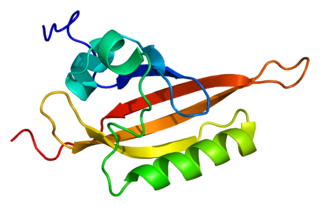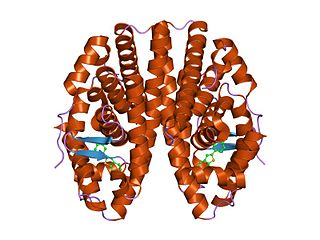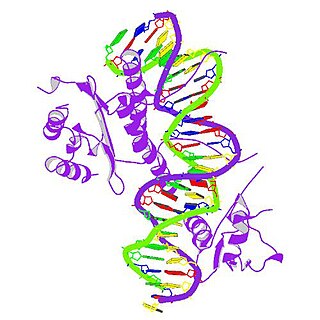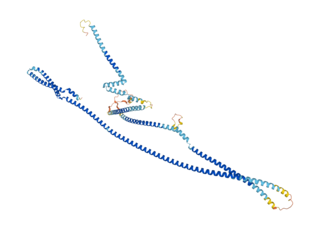POU domain, class 2, transcription factor 1 is a protein that in humans is encoded by the POU2F1 gene. [5] [6]
POU domain, class 2, transcription factor 1 is a protein that in humans is encoded by the POU2F1 gene. [5] [6]
POU2F1 has been shown to interact with:

Oct-4, also known as POU5F1, is a protein that in humans is encoded by the POU5F1 gene. Oct-4 is a homeodomain transcription factor of the POU family. It is critically involved in the self-renewal of undifferentiated embryonic stem cells. As such, it is frequently used as a marker for undifferentiated cells. Oct-4 expression must be closely regulated; too much or too little will cause differentiation of the cells.

The TATA-binding protein (TBP) is a general transcription factor that binds specifically to a DNA sequence called the TATA box. This DNA sequence is found about 30 base pairs upstream of the transcription start site in some eukaryotic gene promoters.

The ARNT gene encodes the aryl hydrocarbon receptor nuclear translocator protein that forms a complex with ligand-bound aryl hydrocarbon receptor (AhR), and is required for receptor function. The encoded protein has also been identified as the beta subunit of a heterodimeric transcription factor, hypoxia-inducible factor 1 (HIF1). A t(1;12)(q21;p13) translocation, which results in a TEL-ARNT fusion protein, is associated with acute myeloblastic leukemia. Three alternatively spliced variants encoding different isoforms have been described for this gene.

The nuclear receptor coactivator 2 also known as NCoA-2 is a protein that in humans is encoded by the NCOA2 gene. NCoA-2 is also frequently called glucocorticoid receptor-interacting protein 1 (GRIP1), steroid receptor coactivator-2 (SRC-2), or transcriptional mediators/intermediary factor 2 (TIF2).

Retinoid X receptor alpha (RXR-alpha), also known as NR2B1 is a nuclear receptor that in humans is encoded by the RXRA gene.

Ku80 is a protein that, in humans, is encoded by the XRCC5 gene. Together, Ku70 and Ku80 make up the Ku heterodimer, which binds to DNA double-strand break ends and is required for the non-homologous end joining (NHEJ) pathway of DNA repair. It is also required for V(D)J recombination, which utilizes the NHEJ pathway to promote antigen diversity in the mammalian immune system.

Nuclear transcription factor Y subunit beta is a protein that in humans is encoded by the NFYB gene.

Serum response factor, also known as SRF, is a transcription factor protein.
POU is a family of eukaryotic transcription factors that have well-conserved homeodomains. The Pou domain is a bipartite DNA binding domain found in these proteins.

Myocyte-specific enhancer factor 2A is a protein that in humans is encoded by the MEF2A gene. MEF2A is a transcription factor in the Mef2 family. In humans it is located on chromosome 15q26. Certain mutations in MEF2A cause an autosomal dominant form of coronary artery disease and myocardial infarction.

Cux1 is a homeodomain protein that in humans is encoded by the CUX1 gene.

TAF9 RNA polymerase II, TATA box binding protein (TBP)-associated factor, 32kDa, also known as TAF9, is a protein that in humans is encoded by the TAF9 gene.

Nuclear receptor coactivator 6 is a protein that in humans is encoded by the NCOA6 gene.

POU domain class 2-associating factor 1 is a protein that in humans is encoded by the POU2AF1 gene. The protein is also termed Oct coactivator from B cells, Oct binding factor 1, and, as commonly found in the literature, BOB1. BOB1 is a transcriptional coactivator which is expressed principally by B-cell lymphocytes and controls immunoglobulin and other genes critical for these cells expression of CD20, CRISP-3, and CD36. The expression of BOB1 has proven useful for identifying certain lymphomas as being B-cell lymphomas, as exemplified in studies which use BOB1 expression to help identify lymphomas as being diffuse large B-cell lymphomas, not otherwise specified.

Solute carrier family 22 member 1 is a protein that in humans is encoded by the gene SLC22A1.

Interferon regulatory factor 8 (IRF8) also known as interferon consensus sequence-binding protein (ICSBP), is a protein that in humans is encoded by the IRF8 gene. IRF8 is a transcription factor that plays critical roles in the regulation of lineage commitment and in myeloid cell maturation including the decision for a common myeloid progenitor (CMP) to differentiate into a monocyte precursor cell.

Nuclear transcription factor Y subunit gamma is a protein that in humans is encoded by the NFYC gene.

POU domain, class 3, transcription factor 2 is a protein that in humans is encoded by the POU3F2 gene.

Homeobox protein Hox-C4 is a protein that in humans is encoded by the HOXC4 gene.

POU domain, class 2, transcription factor 3 is a protein that in humans is encoded by the POU2F3 gene.